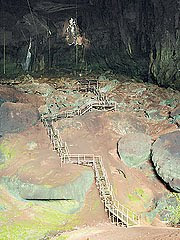 Entrance to the Niah National Park
Entrance to the Niah National Park Lots of caves to explore
Lots of caves to explore A birds nest
A birds nest Wooden walkway inside the cavern
Wooden walkway inside the cavern A beam of light shines into the cavern from an entry point
A beam of light shines into the cavern from an entry point The entrance into the Niah Great Cave
The entrance into the Niah Great Cave Small huts can be seen inside the caves
Small huts can be seen inside the caves Ladders in place for people harvesting birds nests
Ladders in place for people harvesting birds nests
Photos courtesy of and Copyright to Dell and Brunei Press Sdn BhdFor many of us, a weekend escape to the neighbouring town of Miri City usually means shopping, relaxation, great bargains, and more shopping. Not many of us would consider doing anything other than that. However, next time, try adding a new to-do item on your list - go on a visit to the Niah Caves. Caves may not be your idea of relaxation or satisfy your need to engage in shopping therapy, but it is an experience that should really be tried.
The Niah Caves are located within the district of Miri in Sarawak, Malaysia, and is part of the Niah National Park. Its main cave, the Niah Great Cave, is located on Gunung Subis and is made up of several voluminous, high-ceilinged chambers. The Great Cave lies in a large limestone block, about a kilometer in length from a general north-south direction, about half a kilometer wide and is detached from the main Gunung Subis complex, by a valley around 150 to 200 metres wide.
According to online research, Sarawak's Niah Caves are said to be among the most important archaeological sites in Southeast Asia. It is also said that forty thousand years ago, the Niah Great Cave once sheltered human life, where the oldest human remains in Southeast Asia lies, along with many other elics of prehistoric man. Upon arrival you can see a three kilmetre plank walk which will guide and lead you through the beautiful rainforest to the caves. Do remember to bring a flashlight as a precautionary measure though. Among the many different caves that are available in Niah Caves - the Niah Great Cave is the most spectacular; with its imposing vast interior mirroring the character of a huge labyrinth, accompanied with tremendous shafts opening from the surface through the ceiling far above.
Walking through the caves, there will be times when you would see rainwater pouring hundreds of feet down the biggest of these shafts in a dazzling while flocks of swifts swirl overhead, their calls echoing throughout the cavern.
Moving on, one will discover that the floor of the cave is very jagged and every surface is covered with a slimy layer of guano. Guano is the excrement of sea birds that reside within the caves. There are also small huts situated around the caves for guano miners and bird's nest harvesters to take shelter in. Slender bamboo poles are erected vertically to the ceiling by as much as 200 feet for use as ladders for bird's nest harvesters.
At least fifty spine-tinglingly ancient discoveries have been made in Sarawak's caves, which are suspected to have been in use by the indigenous human population since the Pleistocene era. The Niah Great Cave is the most exciting of them all as it was the site of the discovery of the oldest human skull ever found in Asia. Archaeologists have dated it at around forty thousand years old, making it the property of a young gentleman from the Holocene era.
The remains of Neolithic humans, along with fascinating evidence of how their habits and daily lives would have changed over the centuries, are available to view at the Sarawak Museum in Kuching. The Niah Great Cave is also famous for its incredibly well-preserved cave paintings, some of which depict strange, skeletal longboats bearing their passengers to the land of the dead, and for the ancient Borneo tradition of swallows' nest-collecting.
Further exploration will reveal a painted cave known for its well-preserved and highly complex prehistoric cave paintings.The paintings can be difficult to see unless you allow your eyes to become accustomed to the dim light. They are rendered in red hematite and cover a long narrow strip (approximately 30 metres) at the back of the wall. They portray spread-eagled human figures, probably representing warriors and hunters, some of the animals of the souls of the deceased on the dangerous journey to the land of the dead.
Although the burial site at the painted cave is far more recent than those at the Great Cave, it is no less important as it offers a clear insight into the development of the traditional religions of Borneo. It is worth spending some time at the painted cave, as the atmosphere of the place is very tranquil.
Even if you feel that a visit to the Niah Caves is not exactly your cup of tea, give yourselves and the Niah Caves a chance. I was also initially reluctant, giving up the comfort of air-conditioned malls, lattes and crème brulee in exchange for some rough outdoor activity such as adventuring through the caves, but if I had not chose to visit the Niah Caves, I wouldn't' have seen first hand how wonderful an experience the discovery of natural beauty can be.
Courtesy of Borneo Bulletin.
.



















